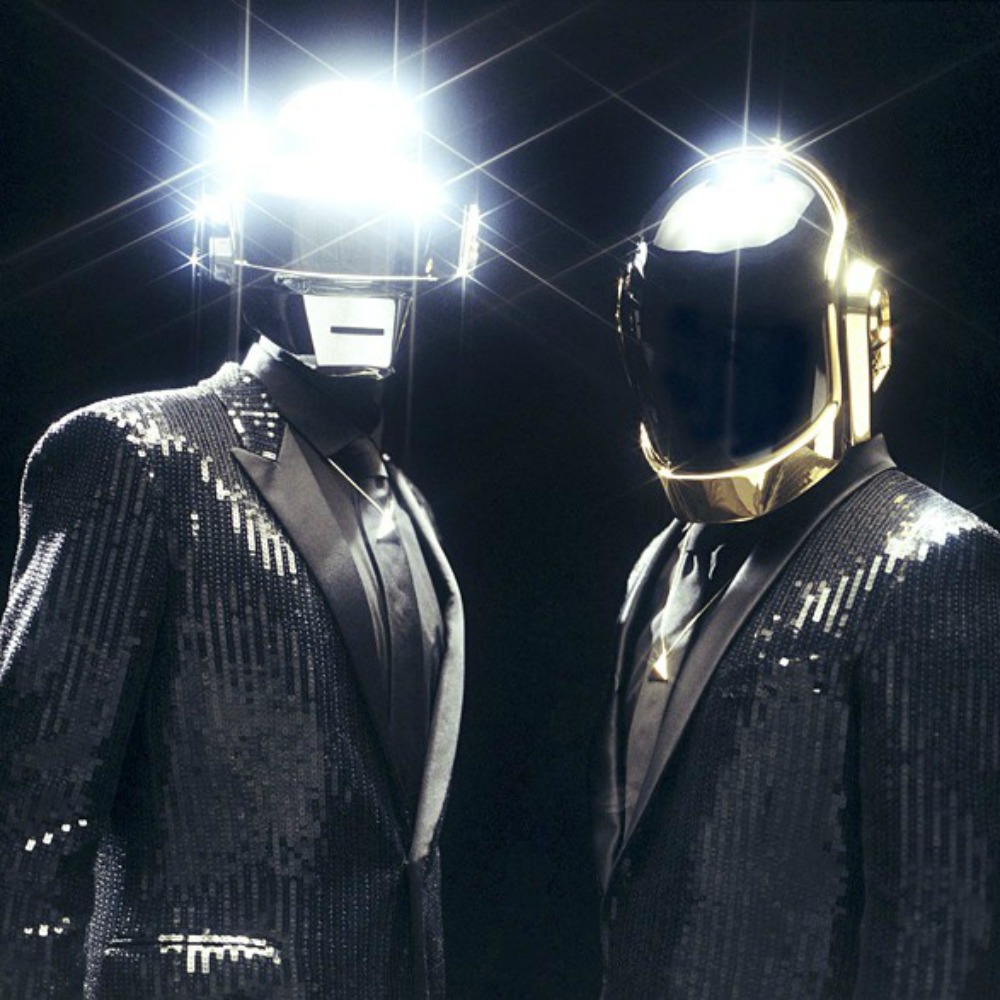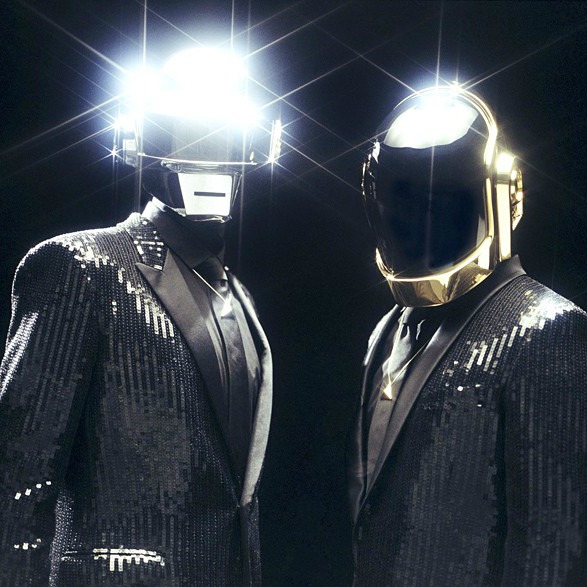ONLY NOISE: French Touch Me – A Love Letter To Daft Punk

There is a fetish for everything. Balloons. Urine. My Little Pony. Robots. Uncertain of the latter’s existence, I confirmed my suspicion via google. Sure enough, sexbots, cyborg fantasies, AI cosplay…all real things. And why wouldn’t they be? Films like Simone, Her, and Ex Machina, to name a few, have all addressed bot-positive love; the bond between man and machine. It’s only natural. At the end of the day it’s no shocker that a niche of the fetish community is reserved for Bicentennial Man’s nuts and bolts, but I was dismayed by two things during my research: 1) That the robot erotica community somehow missed the opportunity to coin the phrase “Robotica,” (which turns out to be a journal of the International Federation of Robotics) and 2) that there was no specific group dedicated to the ultimate robots, the droids that stole my heart: Daft Punk.
Are they not the sexiest bots to grace this planet? Their helmets, so shiny, their Frenchiness, their little matching outfits often made of leather-it’s all quite similar to certain costumes of the BDSM world. And yet, the closest thing I could find on the web alluding to the link between the French house duo and kink was an inflatable jacket with their name dubiously smacked on the title. Is it just me? Am I the only person who has a hard on for the helmet twins? It cannot be!
My introduction to Daft Punk, as with all good love stories, was at first pained. Their name was deceiving. “Punk, you say?” Popping in a friend’s copy of Discovery did not yield the expected results. It was plain false advertising.
House music? Techno? This was the noise I heard bleating up from my sister’s bedroom at 2 am. This was the soundtrack to her flirtation with “candy” bracelets and insufferably baggy jeans. This was not punk. Little did I know that within a decade the duo of faceless Frenchmen would steer me through my college thesis, teach me the subtle elegance of chair dancing, and open my eyes to a whole new kind of sexy: Robotica.
It was actually Stardust’s “Music Sounds Better With You” that first flipped my French Touch switch. The song was a one-off collaboration between Daft Punk’s Thomas Bangalter, the legendary bassist Alan Braxe, and Benjamin Diamond. It was, for me alone, the unofficial anthem of a half-assed relationship I was in while studying overseas in 2012/13. But it became the spark that set off a whole new set of synapses in my brain, the thing that allowed me to enjoy an entire genre I’d brushed off for ten years.
The mystifying thing about French house music is its ability to sound both undeniably cheesy-dated, even, and unassailably cool at the same time. It is nothing short of irresistible. Given the genre’s component parts-Giorgio Moroder-era disco glitter and more aggressive synth technology, it can be intoxicating if you just give in and let the boundaries of what “music” means melt away. There is a brilliant monologue by Mr. Moroder in 2013’s Random Access Memories that speaks to this perfectly: “Once you free your mind about a concept of harmony, and of music being correct, you can do whatever you want…” It is a succinct ideology, but when applied can truly boost the enjoyability index of any given song.
Random Access Memories hadn’t quite hit the shelves when I was tripping over “Music Sounds Better With You,” but I was intrinsically learning Moroder’s philosophy. Though the sparseness and repetition of the lyrics in “Music” could easily be mistaken for lazy writing, I found it more akin to poetic device; beats building, cresting like waves and crashing again, all while anchored with a simple phrase: “I feel right. The music sounds better with you.” A romantic but familiar notion, I related to the image of everyday experiences being elevated at the side of a loved one. Then again, they could have been singing about drugs.
Stardust’s hit sufficed for a while, but eventually I needed to dig deeper. I spent the better part of a year at school by day, and by night at a little glass table facing the wall of my fun-sized kitchen in Milan. The sewing rooms close early in Italy, as does everything else, and I had to make do with this makeshift studio. Sitting in a wooden chair hand sewing buttons or basting seams into the wee hours, I needed a specific sound to keep me going. My initial regimen of 69 Love Songs by The Magnetic Fields and Vietnam War documentaries were somehow not doing the trick-but maybe electronica would.
Compartmentalizing music into task-oriented playlists is not my ideal listening experience, but sometimes it happens without thought. You don’t tend to put on speed metal if you want to relax, or Yoko Ono if you want to make sweet love. Seeing as my driving mission at the time was to stay awake, keep moving and remain somehow upbeat, Daft Punk inadvertently scored my final year of college. Posted at my little table I would sew until three am nightly, dancing vehemently from the waist up in my chair.
I began with 1997’s Homework, in part for chronology’s sake, but also because I couldn’t resist listening to something called Homework while doing homework. It’s an album that continues to impress me every time I hear it, including right now as it accompanies the formless staccatos of my keyboard. At the center of the record is the duo’s breakout club hit “Around The World.” It is the cleanest moment on the LP, foreshadowing Bangalter and Guy-Manuel de Homem-Chritso’s prowess at the soundboard. If you were being reductive, you could again call the song repetitive, but a closer listen reveals the early inner-workings of two helmets who know how to make you dance. The steady funk bass line, the flitting synths, the unrelenting beat…it’s one of many masterpieces on the album.
Homework is a landmark record not only for its evident genius, it is also the only time we get to hear Daft Punk this raw. Most of the record is unpolished, combative even. The p-word in their moniker seems to fit here, as the songs threaten a new era of relentless partying, and an unforeseen way of writing music. Tracks like “Da Funk,” “Rock’n Roll,” and “Rollin’ and Scratchin,’”-with its hostile beat and shrieking synthesizers, are nothing if not punk as fuck.
I kept going. Discovery, TRON: Legacy (the soundtrack), Human After All. I loved each for their own qualities, and appreciated that not one was like the next. Up to Random Access Memories, which cleaned up at the Grammy’s in 2013, Discovery had been Daft Punk’s pièce de résistance to many. And it’s easy to understand why. Where Homework is full of blood and gristle, Discovery is glittering and out of this world. Made by robots yes, but robots with crushes, robots programmed to party. It has admittedly become my go-to workout record, and though it’s a rare occasion that I do workout, I never tire of hearing it. Instead of remembering how boring and ultimately pointless one hour on the elliptical can be, I can instead focus on the intricacies of each song, the little riffs that slip away when you hear it at a bar, the madcap attention to detail that is palpable throughout. The way it makes your body move…I catch something new with each listen.
As someone who used to vilify the “non-traditional” instruments of electronic music, learning to love them has been an uncanny experience. I never have any idea what’s going on. What just made that sound? I don’t know. It is an endless source of surprise and wonderment for me to hear an aural universe unencumbered by the traditional triad of bass, drums, and guitar. The element of surprise is always rife with Daft Punk; it’s a consistent aspect of their compositions, their helmeted appearance, and their ability to pop out of nowhere with new music and annihilate the charts.
May 2013 was the month I graduated, but it was also the month the robots unleashed Random Access Memories, their first non-soundtrack, studio album in eight years. The music world was abuzz. Leading up to the record’s release the duo dropped a 15-second sample of “Get Lucky” as a sort of mini-commercial during an SNL broadcast. The blip oddly enough is still my favorite part of the song-that tasty Nile Rogers guitar riff in the bridge. And thanks to the wiz who looped it on repeat for 10 hours, I can still enjoy it in a vacuum. “Get Lucky” became the song of the summer, and though it’s by far not the best track on Random Access, it was infinitely superior to the summer jam of 2012: “Call Me Maybe.”
“Get Lucky” followed me to a fashion internship in London, where it became the only song on the top-40 radio station the seamstresses listened to that didn’t make me want to put my face under the industrial iron press. Needless to say it holds a special place in my heart, as does the entire record. The platinum hands that were lent to its creation-Rogers, Moroder, Pharrell, and Panda Bear to name but a few, are met with the gilded genius of Bangalter and Homem-Christo, creating a record that truly sounds like nothing else.
Returning to the States, I was shameful and amused that I’d spent a year in Europe and suddenly discovered electronic music. How lame. On the flight from Heathrow to Detroit a woman sat next to me flipping through the September issue of Vogue. There on the page were two dashing robots in gleaming helmets and YSL suits, sandwiching a supermodel. I got excited. Too excited. “Had I known Daft Punk would be in the new issue,” I thought “I would have bought it!” I glanced over the woman’s shoulder until she retired the magazine, hoping she hadn’t noticed. She probably had.
I was changed. My friends were concerned. One time, in the late night last sips of a friend’s house party, five of us were dancing to Paul Simon. “Wait!” I urged. “Lemme put something on!” Going from “You Can Call Me Al” to Daft Punk’s “Face To Face” was not the wisest DJ move. Everyone looked puzzled, but I persisted: “Hold on guys! It gets really good! Just wait for the BASS to drop!”
They still haven’t forgiven me.
Another time, while in a record store in Seattle, I stood in front of a Daft Punk cardboard cutout for twenty minutes, devising a way I could get it back to New York without feeling like a complete psycho, or worse, a 43 year old man who lives in his parent’s basement.
Certain idiosyncrasies don’t develop until adulthood. Certain affinities are never explained, but they can be admitted:
Daft Punk, I love you. You can leave your helmets on.


